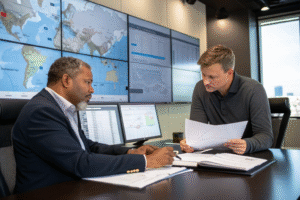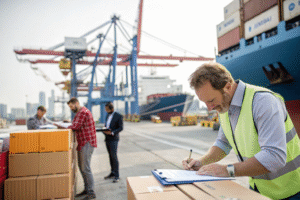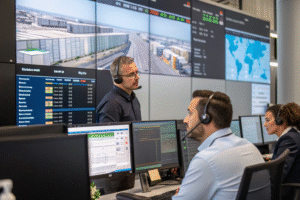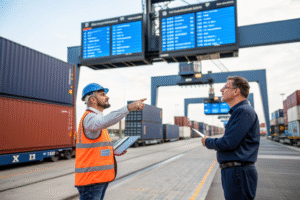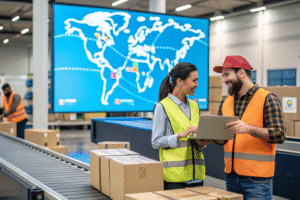In the world of global trade, visibility is everything. Importers like Ron—shipping high-value goods from China to the U.S.—can’t afford to lose track of their cargo. A delay without notice, a missing container, or an unexpected customs hold can throw off production schedules, marketing launches, or retail distribution.
The best method to track shipments internationally is by using integrated, real-time freight tracking platforms provided by experienced freight forwarders, combining GPS, carrier data, customs milestones, and predictive analytics.
At GeeseCargo, we give our clients full visibility across every mode of transport—air, ocean, rail, and road—so nothing is left to chance. Here’s how shipment tracking works today, and how we make it better.
What Are the Main Shipment Tracking Technologies?
Global tracking isn’t just one system—it’s a combination of tools and data from multiple players in the supply chain.
Shipment tracking relies on GPS devices, carrier integrations, cloud-based dashboards, and automated milestone alerts across multiple systems.

How Does GPS-Based Tracking Work for Freight?
GPS tracking is primarily used for truck and rail freight, but advanced solutions now include ocean containers too. Devices like Tive trackers or Roambee sensors are attached to pallets or containers and transmit real-time location and temperature data.
They’re especially useful for high-value, temperature-sensitive, or urgent shipments.
What Digital Platforms Do Freight Forwarders Use?
We integrate tools like FourKites, Project44, and CargoWise One to centralize tracking across carriers, modes, and ports. Clients get access to a custom dashboard with all shipments and statuses in one place.
This avoids jumping between websites and emails just to find your cargo.
How Are Milestones and Customs Events Tracked?
Knowing where a shipment is isn’t enough. You need to know what stage it’s in, and whether it’s on schedule.
Modern tracking systems capture key milestones such as pickup, customs release, port arrival, vessel departure, and delivery confirmation.

How Do You Track Customs Status and Release?
We receive automated updates through ACE (Automated Commercial Environment) for U.S. entries and similar systems in China. These updates tell us whether cargo is “Released,” “Held,” or “Inspected,” and we forward these updates directly to clients.
We also use CargoDocs for electronic document handling and status visibility.
Can You Track Transshipment and Delay Events?
Yes. We track when cargo changes vessels (transshipment), gets held due to congestion, or faces weather-related rerouting. We use PortCast and MarineTraffic to predict schedule deviations.
This is critical for Ron, who needs to alert his warehouse when delays occur on the water—not just after they happen.
What Are the Best Tools for Client-Facing Visibility?
Clients don’t want to call forwarders every time they need an update. That’s why visual, real-time dashboards are a must.
Freight forwarders offer white-labeled client dashboards with map-based tracking, document access, milestone logs, and live chat support.

What Platforms Offer the Best UI for Clients?
We recommend platforms like Freightos WebCargo for ease of use, or our own GeeseCargo client portal that integrates with Trello and Slack. Clients like Ron can log in, filter by PO number, and see every order’s status in seconds.
We also support mobile-friendly dashboards for on-the-go updates.
Can Clients Access Shipping Docs and Invoices?
Yes. Our system connects tracking data with electronic documents—commercial invoices, packing lists, HS code info, and customs clearance files. All stored securely via Dropbox Business or Google Drive integrations.
This reduces back-and-forth emails and speeds up customs audits or delivery planning.
How Do Forwarders Use Predictive Tracking and Alerts?
Knowing what happened is good. Knowing what will happen next is better.
The best shipment tracking includes predictive ETAs, risk alerts, and automated notifications so you’re never caught off guard.

How Do Predictive ETAs Work?
Tools like Project44 use AI to estimate arrival times based on vessel speed, route history, and port congestion. If Ron’s container is falling behind, we get alerted—and so does he—with a new ETA and updated delivery timeline.
This allows his team to reschedule labor, adjust e-commerce stock, or reroute last-mile delivery.
What Types of Alerts Can Clients Receive?
We offer email, WhatsApp, and SMS notifications for:
- Departure and arrival at port
- Customs clearance
- Last-mile truck dispatch
- Delay warnings and alternative suggestions
These alerts are powered by integrations with AfterShip and EasyPost depending on destination.
Conclusion
In international logistics, what you can’t see can hurt you. That’s why reliable, real-time shipment tracking isn’t a luxury—it’s a necessity.
At GeeseCargo, we deliver shipment visibility from factory to final warehouse. Whether you’re managing sea freight to L.A., air cargo to JFK, or rail to Germany, we combine GPS data, customs insights, and predictive alerts to keep you one step ahead.
If you're ready to stop guessing where your freight is and start tracking it with confidence, let's get moving—together.

